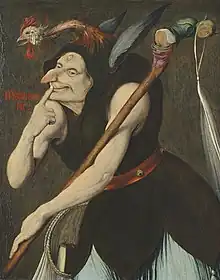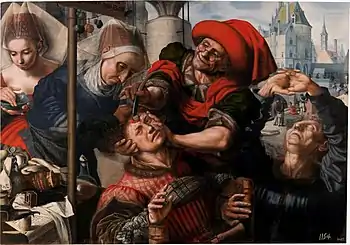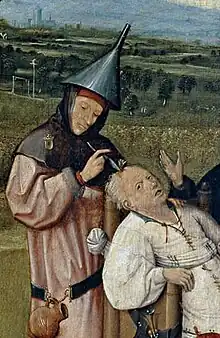The stone of madness, also called stone of folly, was a hypothetical stone in a patient's head, thought to be the cause of madness, idiocy or dementia. From the 15th century onwards, removing the stone by trepanation was proposed as a remedy.[1][2] This procedure is demonstrated in the painting The Extraction of the Stone of Madness by Hieronymus Bosch.[3]
Gallery
 Quentin Massys, An Allegory of Folly (early 16th century). The fool has a "stone of folly" in his forehead.
Quentin Massys, An Allegory of Folly (early 16th century). The fool has a "stone of folly" in his forehead. Pieter Huys, A surgeon extracting the stone of folly
Pieter Huys, A surgeon extracting the stone of folly Jan Sanders van Hemessen, 1550s
Jan Sanders van Hemessen, 1550s After Hieronymus Bosch, 16th century
After Hieronymus Bosch, 16th century Pieter Jansz. Quast,
Pieter Jansz. Quast,
Die Steinoperation, ca 1630
References
- ↑ Vigué, Jordi (2002). Great Masters of Western Art. Watson-Guptill. p. 71. ISBN 0-8230-2113-0.
- ↑ Shorter, Edward (1997). A History of Psychiatry. Wiley. p. 225. ISBN 0-471-24531-3.
- ↑ Povoledo, Elisabetta (October 27, 2008). "In Rome, a New Museum Invites a Hands-On Approach to Insanity". The Economist. Retrieved 2008-10-28.
External links
Wikimedia Commons has media related to Trepanation.
This article is issued from Wikipedia. The text is licensed under Creative Commons - Attribution - Sharealike. Additional terms may apply for the media files.
